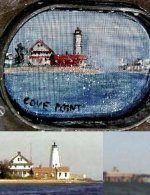greatgrandma
Silver member
- Joined
- 31 January 2025
- Posts
- 616
- Likes
- 2,556
- Name
- Rosalie
The Cedar Point Light originally located on a tiny island off Cedar Point at the southern entrance to Patuxent River was built in 1896. It sat on 1.54 acres with a three-story brick and cedar-shingle house crowned by a 50-foot tower housing lens and fog bell tower, oil house, boathouse, outhouse and barn. A radar reflector now stands in place of the century-old crumbling lighthouse.

Cedar Point Light was made inactive in 1928 and was on the Lighthouse Digest Doomsday List. In 1957 the bell tower collapsed during a storm. The Navy removed the cupola in 1981. The lighthouse was finally demolished in 1996. Portions of the keeper's house were donated to the Calvert Marine Museum. St. Mary's County officials (under the impression that the Navy had given the cupola to them) wanted the lantern for the Piney Point Lighthouse Museum and Park and the Calvert Marine Museum also wanted it. But the Navy felt that it ought to remain near to its original location unless the Commissioners approved a Lexington Park master plan where it would be installed as a historic marker in the Lexington Park Circle which would be close to where it is now.

It is still displayed on the grounds of the Patuxent River Naval Air Museum. There are also photos (such as this one) on display in the museum and there is also a diorama of how the lighthouse originally looked.

When I was researching lighthouses of the Chesapeake to make screen paintings of them, I used the photos and reconstruction to paint my picture
Cedar Point Light was made inactive in 1928 and was on the Lighthouse Digest Doomsday List. In 1957 the bell tower collapsed during a storm. The Navy removed the cupola in 1981. The lighthouse was finally demolished in 1996. Portions of the keeper's house were donated to the Calvert Marine Museum. St. Mary's County officials (under the impression that the Navy had given the cupola to them) wanted the lantern for the Piney Point Lighthouse Museum and Park and the Calvert Marine Museum also wanted it. But the Navy felt that it ought to remain near to its original location unless the Commissioners approved a Lexington Park master plan where it would be installed as a historic marker in the Lexington Park Circle which would be close to where it is now.
It is still displayed on the grounds of the Patuxent River Naval Air Museum. There are also photos (such as this one) on display in the museum and there is also a diorama of how the lighthouse originally looked.
When I was researching lighthouses of the Chesapeake to make screen paintings of them, I used the photos and reconstruction to paint my picture









